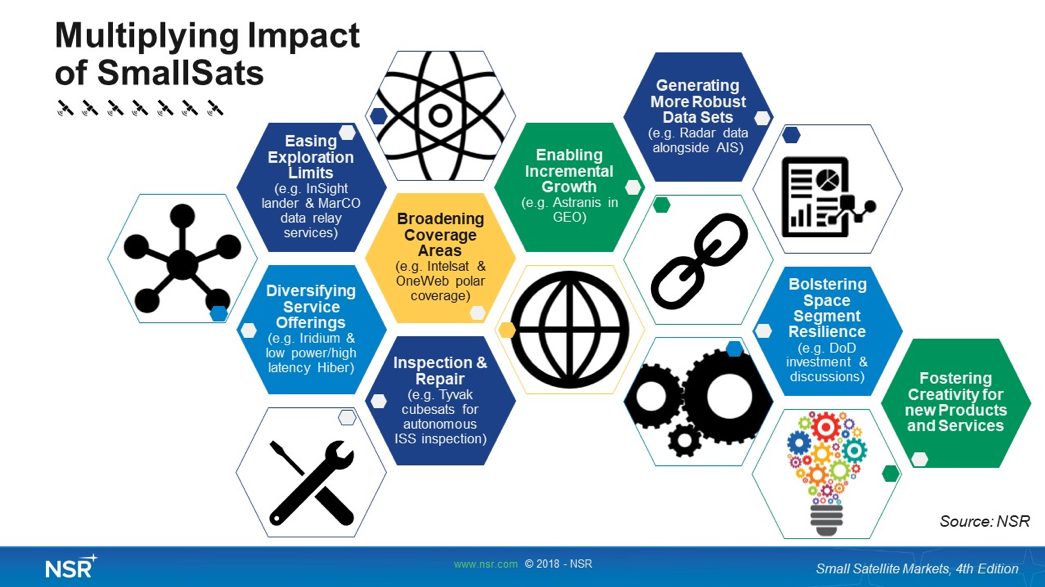With Smallsats, Can 1 + 1 = 3?
Mar 21st, 2018 by Carolyn Belle, NSR
Attendance at last week’s SATELLITE 2018 in Washington, D.C.
demonstrated the expansion of the traditionally GEO communications
focused satellite industry to a more diverse collection of players and
applications. Discussions of broadband connectivity, the potential of
Big Data, and cost reduction involved established and emerging players
alike, with smallsats entering the dialogue more than ever before. Given
the challenges and opportunities facing the satellite industry today,
can more capable smallsats enhance architectures and add value?
Multiple commercial projects point to a resounding ‘Yes’. Last month
start-up Astranis announced a $13.5M Series A to fund development of
~300 kg GEO satellites, targeted for operations in partnership with a
GEO telecommunications operator. Eutelsat publicized the new ELO
program, starting with technology development cubesats from Tyvak to
build out capabilities in the IoT marketplace to complement existing
video and data business. The ELO announcement continues the series
of established GEO and LEO satcom operators looking to diversify their
fleets with non-traditional assets: Intelsat + OneWeb, Telesat’s LEO,
JSAT + LeoSat, Thuraya + Astrocast, and Iridium + Hiber (ex-Magnitude
Space), etc.
On the military side, U.S. DoD news in recent months highlighted the
rising importance placed on resiliency and the risks of relying on few,
high value assets in a more contentious world. Projects such as DARPA’s
Blackjack, SMC’s ongoing Space Enterprise Vision, evolved SBIRS, etc.
support an overall aim of more diverse architectures that can better
address a range of requirements and operational contingencies.
NSR’s Small Satellite Markets, 4th
Edition forecasts $25B in manufacturing and launch revenue over the next
decade – a significant figure, but one dwarfed by the impact of services
that is truly driving this market. Some of this will come from unique
services offered by smallsats alone, but NSR finds growing potential for
smallsats to create value when operating alongside larger birds in
integrated systems.

NSR sees potential for an outsized impact on both the communications and
the remote sensing sides of the market, as well as in growing demand for
situational awareness. Commercial developments incorporating smallsats
are not simply bids to expand revenue streams via adding new services,
nor can their value be reduced to only lower cost or often-cited rapid
technology refresh possibilities. There is no one solution, no killer
app, no single benefit to come from smallsats. The advantage is that
smallsats expand the scope of capabilities and flexibility available to
operators, providing new tools to improve overall system efficiency and
value proposition that can be leveraged as needed.
Smallsats are thus simply another piece to the value creation puzzle:
from facilitating rehabilitation of damaged satellites via inspection to
enabling incremental build-out of services to providing multiple
additional data layers for decision makers, smallsats open the door to
new CONOPS and more optimized systems. This can help operators balance
CAPEX, timing of asset deployment and expansion, service capabilities,
and addressable market.
Ultimately, smallsats help to foster a creative approach to delivering
space products and services, a mindset towards innovation that might
pull the industry out of the traditional paradigm that constrains both
cost cutting and market growth.
The Bottom Line
As many attendees realized last week in D.C., for the satellite industry
to move forward and be competitive in the global marketplace, it needs
innovative solutions and a more open approach to addressing demand.
Acting in tandem with larger satellites and diverse assets, smallsats
open the door to enhanced operational potential. A balanced use of
nimbler LEO and GEO smallsats alongside highly capable, larger
satellites provides a flexible way to address the evolving consumer,
enterprise, and government requirements of a more interconnected world.
In some cases, 1+1 really can = 3.